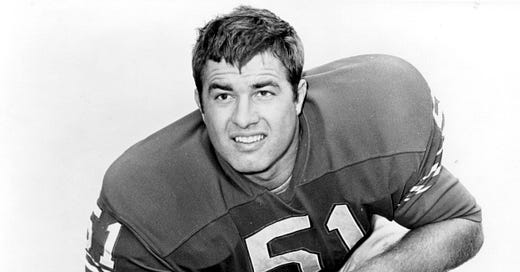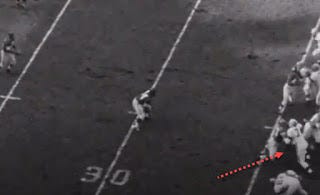Memorial Day weekend special: little-known legend of Don Steinbrunner
Former Browns OT won two Purple Hearts, Flying Cross; killed in Vietnam
By Joe Horrigan, Pro Football Hall of Fame
John Turney, NFL Football Journal
Remembering two NFL Vietnam Veterans on Memorial Weekend — Bob Kalsu and Don Streinbrunner.
(NFL Draft Scout is all about the draft, so note that Kalsu was selected by the Buffalo Bills in the 8th round (199th overall) in the 1968 draft. Don Streinbrunner was selected by the Cleveland Browns in the 6th round (72nd overall) in the 1953 draft)
Horrigan:
In 1978, representatives of the Buffalo Bills presented the Pro Football Hall of Fame with a plaque honoring 1968 rookie guard Bob Kalsu. The plaque recognized Kalsu, who entered the Army following his promising rookie season with the Bills, as the only pro football player to lose his life in combat in Vietnam.
The inscription describes how, on July 21, 1970, following eight months of heavy combat, Lieutenant Kalsu was killed in action when his unit fell under heavy fire while defending Firebase Ripcord on an isolated jungle mountaintop. The Hall, pleased to receive the inscribed tribute plaque, proudly hung it in a prominent place for museum visitors to see, read, and reflect upon.
However, some 30-plus years after Kalsu’s death, the Hall of Fame learned of a second former pro football player, Don Steinbrunner, who died while serving his country in Vietnam.
Steinbrunner, who played offensive tackle in 1953 for the Cleveland Browns, joined the ROTC while in college and was called to active duty following his rookie season with the Browns. Upon completing a two-year tour of duty as an Air Force navigator, the Bellingham, Washington native considered returning to the Browns but instead opted to pursue a military career.
In 1966, Steinbrunner was called to serve in Vietnam. Not long after his arrival, he was shot in the knee during an aerial mission and was offered an opportunity to accept a less dangerous assignment. He declined. According to his family, the 35-year-old Steinbrunner reasoned that he was better suited for the dangerous duty than the younger, less seasoned soldiers he’d observed. It was a decision that cost him his life. On July 20, 1967, Steinbrunner’s plane was shot down over Kon Tum, South Vietnam. There were no survivors.
Steinbrunner was posthumously awarded a second Purple Heart and the Distinguished Flying Cross.
*********
Turney:
Donald Steinbrunner's football career went largely unnoticed. He played just one season (1953) for the Cleveland Browns. He'd primarily been an offensive tackle for the Browns but also played defense and some end. He spent most of his time on special teams, however.
A knee injury ended the sixth-round draft choice's pro football career after only eight games, but he did get to play in the 1953 NFL Championship game, a 17-16 loss to the Detroit Lions.
However, in those eight games, he was teammates with a who's who of NFL greats, including Otto Graham, Len Ford, Bill Willis, Lou Groza, Doug Atkins, Marion Motley, and Dante Lavelli.
Steinbrunner on special teams in 1953
As a rookie lineman, it would seem likely that Steinbrunner's two-a-day practices would have been rather tough, facing Len Ford and Doug Atkins and even George Young in those sessions—in an era when they were going full contact, and not in shells and shorts.
One player he faced in practice, Bill Willis, remembered him: "He wasn't a roughneck. He was a gentlemanly player," said the Hall-of-Fame middle guard.
Hall-of-Fame center Frank Gatski, whom Steinbrunner would have faced when playing defense, had a similar take, "He was a big guy when he came to the team. He was good enough to play a little bit. And he was a nice guy."
Steinbrunner’s teammate at Washington State, Harland Svare, felt that the former Cougar would have been a great tight end but that the position had not yet fully evolved. Said Svare, "He was a great blocker and at 6-3 and 230 pounds who could catch the ball. He would have played a long time."
He joined the United States Air Force in college via ROTC, and after a year in the NFL he was called into active duty, was trained as a navigator and chose to stay in the military. After serving as an assistant football coach at the United States Air Force Academy in Colorado Springs, Colorado, he was transferred to Southeast Asia and was killed in action in Vietnam.
It took decades for his passing to be recognized by the Pro Football Hall of Fame. In its display for NFL players who died while serving in the military, the HOF’s acknowledgement reads: "Some 30-plus years since Bob Kalsu’s untimely death, the Hall of Fame learned of a second pro football player, Don Steinbrunner, who died while serving his country in Vietnam.”
Steinbrunner in Vietnam
It’s reported that Steinbrunner was sent to Vietnam in 1966, and after he was wounded in an aerial mission with a group he'd volunteered to join, he refused a safer assignment and later was killed when his plane went down.
Major Steinbrunner's plane was shot down on July 20, 1967, in Kon Tum province, South Vietnam. There were no survivors among the five crewmen aboard. He was posthumously awarded a Purple Heart and the Distinguished Flying Cross for his valor.
Steinbrunner's Commendations
★ Distinguished Flying Cross
★ Air Medal
★ Purple Heart
★ United States Aviator Badge Air Force
★ National Defense Service Medal
★ Vietnam Campaign Medal
★ Vietnam Service Medal
★ Air Force Presidential Unit Citation
★ Vietnam Gallantry Cross
★ Air Force Good Conduct Medal
Always a Hero
Leading his high school team to an undefeated season in 1947 and then made All-State in 1948 the Mount Baker High School graduate not only lettered in football but also baseball (he was also an All-Stater in hoops), basketball as well as track and field.
At Washington State he played football and basketball (and was a team captain for both squads), making All-Pacific Coast and honorable mention All-American as a senior on the gridiron. He was made the All-Opponent team for seven schools.
A long-forgotten tradition, an All-Opponent team the media would quiz players from schools, asking them who was the toughest opponent they faced that season and compile them into a squad. For example, a tackle would be asked who the toughest defensive end was. An end would be asked who covered him the best, and so on.
Steinbrunner had been in the ROTC at Pullman and after his only season in the NFL he was called into active duty in the Air Force, becoming a navigator rather than a pilot due to his size and also to a vision issue (astigmatism).
At first, the handsome — he modeled some, even having a print ad in Look magazine — ballplayer was planning on returning to the NFL after his active service requirement was met, but he loved flying and also realized his career in football was going to be limited.
So the Steinbrunners (wife Meredyth and children) became a career military family. After a few years of traveling to various base assignments, the navigator got back into football in 1960 as an assistant coach for the Air Force Academy and held that position for five seasons. He also was a recruiter for the Academy, looking for high-quality football talent as well as young men who could pass muster as military men.
A year after his coaching stint ended, he was called to Vietnam. Though he could have avoided combat, he volunteered to join the 12th Air Commando Squadron in the 315th Commando Wing.
As part of Operation Ranch Hand, the squadron's assignment was primarily to spray herbicides in Vietnam, the majority of which was Agent Orange.
The plane fitted with spraying equipment used by the 12th was the Fairchild C-123K Provider. It was large, able to fly low and slow and spray jungles from altitudes as low as 175 feet.
A July 21, 1967 story in The Bellingham Herald, revealed that on his final sortie with the "Spray Birds,” the plane had been shot down, based on a report from a forward air controller who saw a crash near Pleiku Air Base, where a ground fire was also observed.
Pleiku Airbase (now Pleiku Airport) is located in Gia Lai Province in southern Vietnam. Military records show that the Major was shot down over (then referred to as) Kontum Province. Though both are close in proximity—in the Central Highlands region of Vietnam—we are not sure why there is a discrepancy between the official records and the account in the Herald, which used the Air Force as a source.
Regardless, a military investigation revealed the crash was indeed the Provider that Major Steinbrunner was aboard and that no one survived the crash.
His wife never got full details, but she admitted wondering if the cause of the crash was the fuel tank had been pierced by enemy fire or whether the wing caught a tree because of the extremely low altitude. Did her husband die on impact or due to an explosion? Did he survive the crash and was killed by enemy ground fire?
Finally realizing those things didn't matter, she knew enough.
She did know that she loved him and he did also love her. She knew him to be a confident, fearless man who had a "knack for touching people's lives" and also that he was a hero.
Popular war or not, Steinbrunner was a man who wouldn't beg out of dangerous missions and leave it to younger less experienced, perhaps unmarried men, he accepted them because it was his duty and responsibility, and eventually he gave his life.
That is his legacy, and on this Memorial Day Weekend, it is worthy of remembrance.






